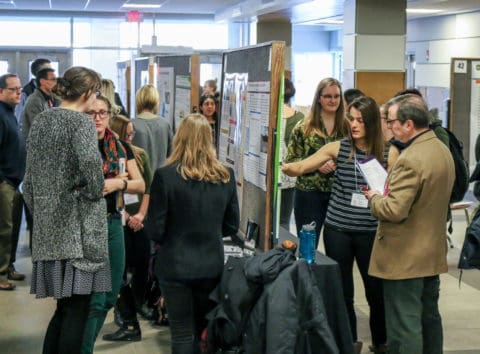On Jan. 26, the University of Saskatchewan showcased a variety of research projects, giving undergraduate students the opportunity to present work to everyone on campus and to see the research of their peers.
The Undergraduate Project Symposium, held this term in the North Concourse of Place Riel, promotes undergraduate work and encourages students to participate in academic research, regardless of their area of study. This year there were 48 applicants, almost double the amount of applicants in previous years. Forty-two of these applicants presented at the symposium.
Brooke Malinoski, vice-president academic affairs of the U of S Students’ Union, spent a lot of time organizing this year’s symposium and was very pleased with the turnout.

Students present their unique research to the public, their peers and faculty judges at the Undergraduate Project Symposium.
“As undergraduate students, you’re an important part of this institution and you contribute a lot to academia,” Malinoski said. “As long as a student is an undergraduate student, they can submit from whatever discipline they study. Or even if they’re taking a class in another discipline, they can submit from that as well. The only requirement is that they’re an undergraduate student.”
Malinoski wants the event to encourage more students to see the value of research and help them understand how much they are capable of contributing to the U of S at the undergraduate level.
Project topics varied from student groups to work and labs with faculty members, art work, research papers and drama pieces. Students will be able to submit applications for the 2018 project symposium in the fall of 2017. They can also email the vice-president academic advisor with further questions.
Courtney Onstad, a fourth-year geology major, was pleased to hear that she tied for first place in the Science and Engineering category and won the Signature Research Area Award.
“I always try my best in events such as these, but it still came as a surprise finding out I had won two awards. It’s very impressive to see all of these undergraduate students who are putting so much time and effort into these projects and I’m pleased we all got to be a part of it,” Onstad said, in an email to the Sheaf.
Participants in the symposium can win in either the Science and Engineering category or the Social Sciences, Humanities and Fine Arts category. Each category includes three ranked winners, determined by faculty judges. The event also includes the People’s Choice Award and Signature Research Area Award.
Onstad’s winning project is called “Preliminary geochemical analysis of host rock lithologies at the Arrow uranium deposit, Athabasca Basin, Saskatchewan: Interpretation of protolith and alteration.”
“My project is focused around analyzing the main rock type that is cut by faults that contain the uranium in a northern Saskatchewan uranium deposit. I am using the chemical composition of the rock, including major elements like aluminum and potassium, to examine variations in alteration and trace elements to investigate the origin of the rock. I will also be looking at thin sections of the rock using a petrographic microscope to identify the minerals of the rock. The aim is to try to understand the origin of the rock and provide the best rock name,” Onstad said.
Onstad explains her findings so far.
“It appears as though the rock was probably an igneous rock, which formed from a magma about two billion years ago and most likely in a volcanic arc setting,” she said.
Onstad plans to use her $800 in prize money for her plane ticket to Toronto, for the Prospectors and Developers Association of Canada Convention in March 2017, which will give her the opportunity to share her research with mining industry professionals.
She believes that the opportunity to take part in the symposium is invaluable experience for undergraduate students.
“Research truly relates your university studies to real world applications. I always found it difficult to make sense of what I was learning in school when I couldn’t see the connection to the professional world,” Onstad said. “There is so much value gained from working on projects such as these. They will help you in your future university studies, they look great on your resumé and they enhance your presentation, research and communication skills.”
—
Sophia Lagimodiere
Photo: Olivia Swerhone-Wick / Supplied